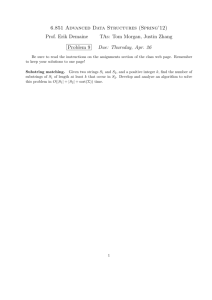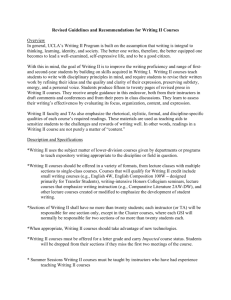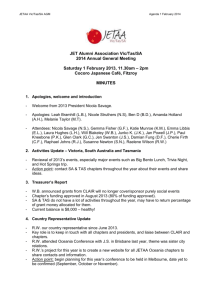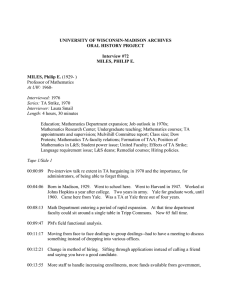- BUGS McGill
advertisement
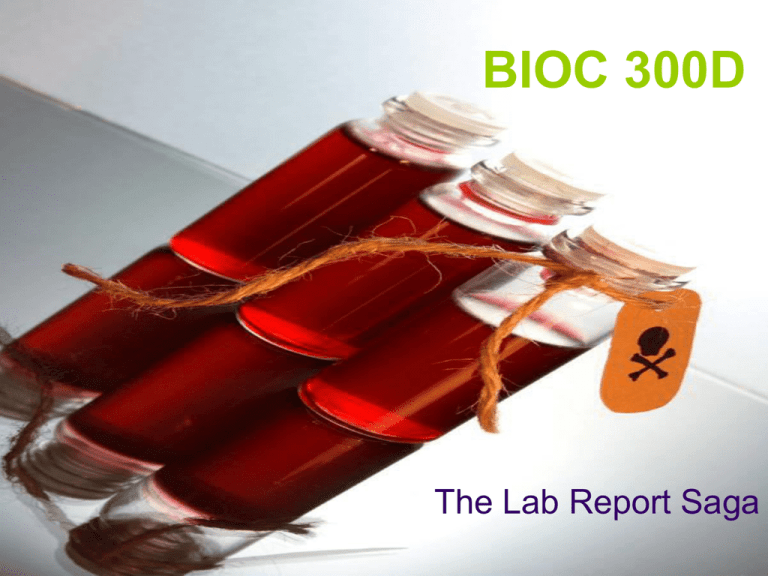
BIOC 300D The Lab Report Saga Getting Started Some points to keep in mind when preparing to write your lab report: 1. When do you want to start? Usually more than a couple of hours before the submission time... Understand the lab protocol. Get together before the lab and make sure you grasp what exactly you are trying to perform. The actual writing of the lab report should not happen in order of presentation. It’s not recommended to start with the abstract. You can actually write your introduction before you perform the lab. Be careful about the formatting. Follow what is given in your guidelines. (Microsoft Word can sometimes be stupid) 2. 3. 4. AND FINALLY, words of wisdom: Talk to your TAs… Remember that they have the privilege of grading you, so it would be ideal to understand their specific preferences and likings. Title Section As indicated in your lab manual: Your name, your ID number Your partner’s name, bench number, lab day The experiment number and name The Summary This should be the last section that you tackle before you hand in your lab report. Similar to the abstract of a scientific paper. TO BE SEEN: Introductory sentence on the topic. Summarize your experiment: methods used and why. Add ALL of the relevant conclusions and numerical values obtained. Finally, a concluding sentence which broadly explains how this experiment is relevant to a field of science. e.g. the importance of restriction analysis in determining plasmid structure, mutations and insertions. Word limit = 100-200 words, but some TAs would prefer that you write a longer summary to include more details. The Summary The study of the Lac Operon in E. coli has revealed a number of important aspects on how gene expression is regulated in prokaryotes. Bacterial growth and a number of properties of the lac operon were investigated. E. coli was grown using glycerol as the carbon source. Growth was monitored using spectrophotometry and viable cell counts. The growth curve obtained using optical methods was standardized in terms of bacterial concentration by using the viable cells counts obtained. Β-galactosidase activity was monitored via spectrophotometry under uninduced (IPTG) and induced conditions. The reaction under study was the hydrolysis of PNPG to p-nitrophenol by βgalactosidase. The generation time was found to be 54.4 and 36.1 minutes, using OD650 and viable cell counts. The stationary phase of bacterial growth was not achieved. Β-galactosidase activity was found to be markedly increased (~3 fold increase) upon IPTG induction. Indeed, the Lac Operon provides E. Coli with a flexible, yet tightly regulated metabolic system. THE OBJECTIVE Within 1 to 2 sentences, explain the purpose of the experiment and the methods used to obtain results. It should start as such: “The objective/purpose of the experiment was to…” e.g. “The purpose of the experiment was to determine the gender of 4 unknown DNA samples. This was done using PCR amplification followed by Gel-Shift analysis.” INTRODUCTION • Introductory sentence • Explain the theory behind the experiment • Give an example of biological relevance • Mention and explain the techniques that are to be used • Mention some alternatives techniques that can be used to accomplish the same goal(*) • Conclude with 1 or 2 sentences introducing the lab and a very brief summary of results (*) • A maximum of 2 pages (*) * Depending on your TA INTRODUCTION • Introductory sentence •Begin with a general statement introducing the topic you are studying and it’s general role in physiology •Ex: Enzymes, lipids, RNAi •This is a good place to lead up to or include the biological relevance of this experiment INTRODUCTION •Biological relevance •Give an example of why the techniques and topics to be studied are important (Applications of the technique in ‘the real world’, diseases linked to the protein or subject under study ) •Be brief : Do not waste space going into a lot of detail about multiple examples. •Easy place to include a reference from a journal •A good way to introduce the experiment INTRODUCTION •Explain the theory behind the experiment •Write for an audience with a basic background in science but no knowledge of pathways discovered, techniques used today, … •Briefly mention all theory relevant to this experiment (important equations, known or suspected functions of the protein under study…) •Note that TAs give points for every fact that they are looking for, not for the length of your explanations •Use the theory outlined in the lab manual and lectures as a guideline. Check with your TA to see if it is ok to cite the manual and lectures. INTRODUCTION •Mention and explain the techniques that are to be used •Write about instruments used for the first time in an experiment and briefly explain how they work. •Explain the goal of each key step. •Ex: Why is the purpose of boiling , freezing or drying the sample at different stages of the experiment? •Explain the importance of reagents used •Ex: Why is it important to treat the sample with a chelating agent, acid, blocking agent etc? •Sources: lab manual, lecture notes, journal articles, procedures from companies like Sigma etc, INTRODUCTION •Mention some alternatives techniques to those used if they exist •See if the lab manual or lecture notes give alternatives to a technique used •Do some outside research if needed •Save techniques that are simply an extension or improvement on what you did for your discussion INTRODUCTION •Conclude with an introduction of the experiment and a brief summary of the results (depending on TA) •Give a brief recapitulation of major results. Stick to major trends or conclusions as opposed to exact numbers or details •Ask your TA if he/she wants this to be included and whether it should be in past or future tense. INTRODUCTION •TIPS •A reader with a basic knowledge or science should be able to deduce what the expected results from this experiment would be from the theory given •Write all necessary information, then cut it to make it only 2 pages. Do not waste space talking in great detail about one thing and lose points for neglecting others •If you find sticking to the page limit easy… you are probably missing pertinent information •Start early and give yourself time to proof read. EXPERIMENTAL PROCEDURE • Simply write “As in lab manual” or “As in lab manual except for the following modifications” and reference the lab manual •Simple… but don’t forget it! Copy / paste it into all your reports and don’t lose 1 point for no good reason! RESULTS Pretty straightforward Remember the details Sample calculations Present all data (including poor data) Answer any questions given Do not analyze data – just state what was found RESULTS Remember the details: Tables are given a title on top and numbered using roman numerals (I, II, III…) Figures are given a title on the bottom and numbered using numbers (1, 2, 3…) Explain your tables and figures Make sure you give the result of a regression in sentence form under your figure (The linear regression yielded a slope of … and an intercept of …) RESULTS Include all sample calculations: This means one calculation for each set Ex: if you calculated the concentrations for a set of samples, only include the first one RESULTS Present all data Show all gels: Use the tables given in the lab manual and make sure you present all figures asked for Present original signed photocopy with raw data Scan and integrate the image into the results (don’t leave them all at the end) Some graphs should be superimposed if they are to be compared Even if a table is not given in the lab manual, you may have to make your own if there is enough data to be presented If your data is unusable: you must still present it, and explain why you are not going to analyse it Then, present another group’s data, and make sure you reference them RESULTS Make sure your presentation flows This is important in their grading criteria Make introduction sentences, link paragraphs and so on. Finally, make sure you include a concluding sentence at the end of your results. Don’t just end it abruptly. RESULTS Answer any questions given Make sure you find all the questions in the lab manual for your experiment and answer them Sometimes they are spread across many pages, so make sure you find all of them Some labs don’t have questions DISCUSSION Introductory sentence (may or may not be required. Much more important to do this in the Introduction section) (12) Present all your main data (again) If a long series of numbers, often sufficient to simply refer back to the table/graph (e.g. values ranged between 5 and 12 (see Table V)) Once data is presented, analyze it and determine whether it is an expected result (12) Also state your logic in predicting the result Make sure to refer back to tables/graphs when mentioning results (e.g. see Table V, Graph 7) Do your best to find theoretical values. May have to look in scientific articles, textbooks, etc. Try not to reference the lab manual (depends on the TA) DISCUSSION Try to be as brief as possible (12) Be concise, but complete Don’t babble! In other words, don’t “pump up” your discussion section with useless words. This tends to give TAs the impression you don’t know what you’re talking about. Suggest improvements to the procedure, especially if something went wrong (2) (8) Ex: if the restriction digest was not complete, the reaction could have been run for longer Suggest alternatives (7) This is important: this will show that (1) you understand the point of the experiment, and (2) you are able to find another method that would accomplish the same thing DISCUSSION Again, part of your grade is on how well your text flows and makes sense Include a relevance to biology (try to find examples on how the technique being studied has been applied in medicine, research, etc.) Make sure you include references here, too Discussion section may also include questions to be answered. Don’t forget to include these. Easy points. In terms of length, it depends on the TA. Usually 1 page (but some TAs will allow you to exceed if you’re “going somewhere” with your discussion). REFERENCES References must be made for all external scientific facts, ideas, or method descriptions mentioned in the report. Requirements for the number and type of sources may vary for different TAs (ask them). Avoid using websites, you should rely more on books and papers from scientific journals. Pubmed is a good source of scientific journals (cite the paper name, not the URL) Ncbi can be used to find values you may need in the report e.g. protein weights A typical lab report will contain 5-15 sources, you can use a source multiple times but make sure you have enough to prove you’ve put effort into researching. You may be able to use your lectures (311/300D) and lab manual as sources but check with your TA. Tip: Use the source lists at the bottom of wikipedia pages if you find something useful there. REFERENCES Book Book Title Author Name(s) Publisher (italics) Publisher City Journal Paper Title Journal (italics) Volume & Year Author Name(s) Page # •Ask your TA if they prefer a specific citation method The Leftovers… At the end of your lab report, always attach your SIGNED flowsheet. Make sure to submit your lab report as PDF Don’t forget to add your raw data. This could include tables, sample calculations and gels! NEVER refer to your raw data in your lab report. In order to integrate this information into your report, add it as a table or figure. Take a scan of your gel and add it as a figure! FINAL TIPS • Find out exactly what each of your TAs want (content-wise AND format) by asking them or reviewing old lab reports and follow their instructions to the letter!!!!!!!!!!!!!!!! •Start writing your lab report ahead of time in order to get help from your TAs if needed and to edit •If you are looking at old lab reports, make a point of NOT taking any sentences from them as other people are likely to have them too… •Come prepared to each lab •Hand in each lab on time (or lose A LOT of points) •Make sure that BOTH partners know how to do techniques that come up a lot (Bradfords, making gels, …)
